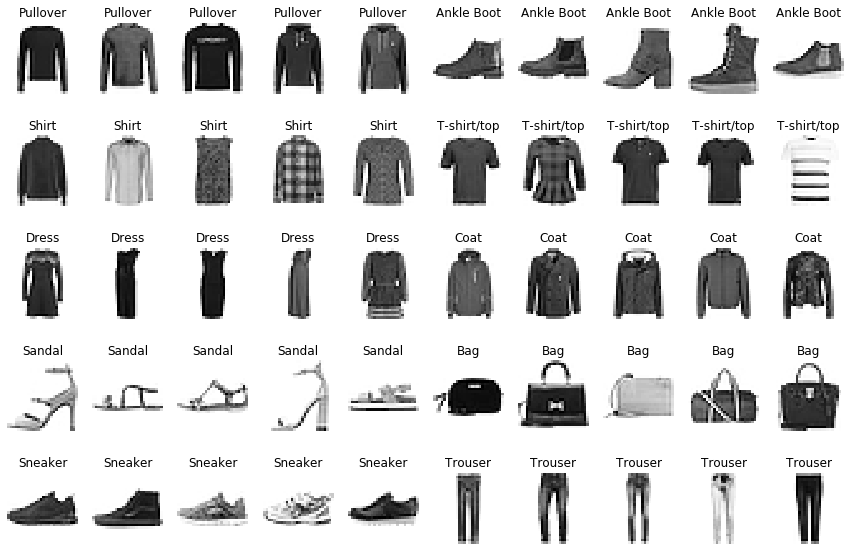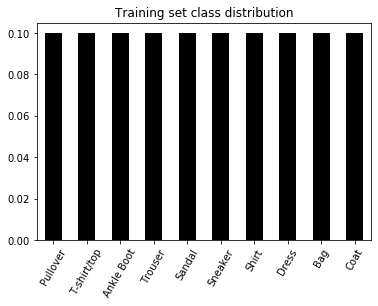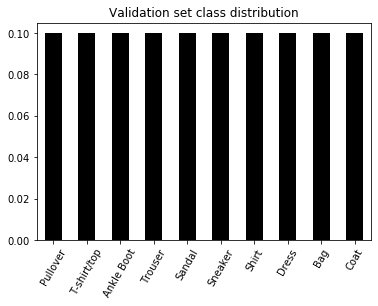Keras CNN for Fashion MNIST Image classification
Explore Fashion MNIST dataset and CNN model
Here we’ll get a feel for the Fashion MNIST image data and the model we’ll be using to classify those images.
Later we’ll train, tune and test the model
Contents
Setup
%matplotlib inline
import matplotlib.pyplot as plt
import numpy as np
import pandas as pd
import os
# filter out FutureWarnings
from warnings import simplefilter
simplefilter(action='ignore', category=FutureWarning)
# Supress Tensorflow Warnings
import tensorflow.compat.v1.logging as logging
logging.set_verbosity(logging.ERROR)
# custom model class
from cnn import FashionMNISTCNN
Using TensorFlow backend.
The Fashion MNIST image data set
More information on the dataset see Github or Kaggle. We’ll use the .csv files from Kaggle for data exploration.
train_data, val_data = pd.read_csv('data/train.csv'), pd.read_csv('data/val.csv')
train_data.info()
<class 'pandas.core.frame.DataFrame'>
RangeIndex: 60000 entries, 0 to 59999
Columns: 785 entries, label to pixel784
dtypes: int64(785)
memory usage: 359.3 MB
val_data.info()
<class 'pandas.core.frame.DataFrame'>
RangeIndex: 10000 entries, 0 to 9999
Columns: 785 entries, label to pixel784
dtypes: int64(785)
memory usage: 59.9 MB
- There are 60,000 images in the training set, and 10,000 in the validation set.
- There are 785 features - a class label and 784 pixels. A row of 784 pixels is a flattened 28 x 28 pixel array
Class representative images
There are 10 image classes
def add_class_str_labels(df):
class_str_labels = ["T-shirt/top", "Trouser", "Pullover", "Dress", "Coat", "Sandal",
"Shirt", "Sneaker", "Bag", "Ankle Boot"]
# dict for mapping labels to string labels
class_mapping = {i: label for (i, label) in enumerate(class_str_labels)}
df['str_label'] = df['label'].apply(lambda x: class_str_labels[x])
add_class_str_labels(train_data)
add_class_str_labels(val_data)
We’ll collect 5 images from each of the 10 classes and plot them
def get_class_images(df, class_str_label, num_images=5):
# slice all rows for this class
class_slice = df[df['str_label'] == class_str_label]
# get 5 random indices
indices = np.random.choice(class_slice.index.values, size=5, replace=False)
# slice images for these indices
image_slice = class_slice.loc[indices, : ]
# return array of 28 x 28 images
return image_slice.drop(columns=['label', 'str_label']).values.reshape(5, 28, 28)
def plot_sample_images(df):
class_str_labels=df['str_label'].unique()
fig, ax = plt.subplots(5, 10, figsize=(15, 10))
for (i, label) in enumerate(class_str_labels):
class_images = get_class_images(df, label)
for (j, image) in enumerate(class_images):
ax[i//2, j + 5*(i%2)].imshow(image, cmap='Greys')
ax[i//2, j + 5*(i%2)].axis('off')
ax[i//2, j + 5*(i%2)].set_title(label)
plot_sample_images(train_data)

Class distributions
We’ll look at how the images are distributed across the image classes in the train and validation sets
# plot class distributions for training and validation data
def plot_class_distribution(df, title):
class_dist = train_data['str_label'].value_counts() / len(train_data)
class_dist.plot(kind='bar', color='k')
plt.title(title)
plt.xticks(rotation=60)
plot_class_distribution(train_data, 'Training set class distribution')

plot_class_distribution(val_data, 'Validation set class distribution')

The classes are perfectly balanced.
Before we begin training a model, we’ll create a perfectly balanced test set from the training data
def balanced_test_split(df, size=10000):
np.random.seed(27)
df = df.copy()
# get class names
class_str_labels = df['str_label'].unique()
# store slices for later concatenation
slices = []
# get slices for all the classes
for class_str_label in class_str_labels:
# slice all rows for this class
class_slice = df[df['str_label'] == class_str_label]
# get indices for test rows
indices = np.random.choice(class_slice.index.values,
size=size//10,
replace=False)
# slice for these indices
slices += [class_slice.loc[indices, : ]]
# drop rows for these indices
df = df.drop(index=indices)
# collect slices into a dataframe
test_df = pd.concat(slices, ignore_index=True)
return df, test_df
train_data, test_data = balanced_test_split(train_data)
train_data.info()
<class 'pandas.core.frame.DataFrame'>
Int64Index: 50000 entries, 0 to 59999
Columns: 786 entries, label to str_label
dtypes: int64(785), object(1)
memory usage: 300.2+ MB
test_data.info()
<class 'pandas.core.frame.DataFrame'>
RangeIndex: 10000 entries, 0 to 9999
Columns: 786 entries, label to str_label
dtypes: int64(785), object(1)
memory usage: 60.0+ MB
Keras CNN Model for classification
Overview
The model we’ll use is a convolutional neural network build using Keras with Tensorflow backend. The CNN is implemented as a wrapper for the Keras functional API class keras.models.Model
The model architecture follows the convention of several convolutional/pooling blocks, then a flattening, followed by a few fully connected layers and finally a softmax layer.
- Convolutional/Pooling blocks - Each convolutional block follows the sequence:
- Zero padding
- 2D convolution
- Batch Normalization
- Activation
- 2D Max Pooling
- Fully Connected layers - Each fully connected layer follows the sequence:
- Batch Normalization
- Dropout
- Activation
INPUT_SHAPE = (28, 28, 1)
model = FashionMNISTCNN(INPUT_SHAPE)
The FashionMNISTCNN class constructor accepts a dictionary of architecture parameters which constructs an arbitary number of conv/pool blocks followed by an arbitarary number of fully connected layers.
By default the CNN has 3 conv/pool layers, 2 fully connected layers, and a softmax layer.
# Default parameters for convolutional/pooling blocks
model.conv_params
{'conv0': {'conv0_pad': 1,
'conv0_channels': 32,
'conv0_filter': 3,
'conv0_stride': 1,
'conv0_pool': 1,
'conv0_activation': 'relu'},
'conv1': {'conv1_pad': 1,
'conv1_channels': 64,
'conv1_filter': 3,
'conv1_stride': 1,
'conv1_pool': 2,
'conv1_activation': 'relu'},
'conv2': {'conv2_pad': 1,
'conv2_channels': 128,
'conv2_filter': 3,
'conv2_stride': 1,
'conv2_pool': 2,
'conv2_activation': 'relu'}}
# Default parameters for fully connected layers
model.fc_params
{'fc0': {'fc0_neurons': 512, 'fc0_activation': 'relu'},
'fc1': {'fc1_neurons': 256, 'fc1_activation': 'relu'},
'fc2': {'fc2_neurons': 10, 'fc2_activation': 'softmax'}}
We’ll inspect the default model with keras built in summary
model.summary()
Model: "fashionmnistcnn_1"
_________________________________________________________________
Layer (type) Output Shape Param #
=================================================================
input_1 (InputLayer) (None, 28, 28, 1) 0
_________________________________________________________________
conv0_pad (ZeroPadding2D) (None, 30, 30, 1) 0
_________________________________________________________________
conv0 (Conv2D) (None, 28, 28, 32) 320
_________________________________________________________________
conv0_bn (BatchNormalization (None, 28, 28, 32) 128
_________________________________________________________________
conv0_act (Activation) (None, 28, 28, 32) 0
_________________________________________________________________
conv0_pool (MaxPooling2D) (None, 28, 28, 32) 0
_________________________________________________________________
conv1_pad (ZeroPadding2D) (None, 30, 30, 32) 0
_________________________________________________________________
conv1 (Conv2D) (None, 28, 28, 64) 18496
_________________________________________________________________
conv1_bn (BatchNormalization (None, 28, 28, 64) 256
_________________________________________________________________
conv1_act (Activation) (None, 28, 28, 64) 0
_________________________________________________________________
conv1_pool (MaxPooling2D) (None, 14, 14, 64) 0
_________________________________________________________________
conv2_pad (ZeroPadding2D) (None, 16, 16, 64) 0
_________________________________________________________________
conv2 (Conv2D) (None, 14, 14, 128) 73856
_________________________________________________________________
conv2_bn (BatchNormalization (None, 14, 14, 128) 512
_________________________________________________________________
conv2_act (Activation) (None, 14, 14, 128) 0
_________________________________________________________________
conv2_pool (MaxPooling2D) (None, 7, 7, 128) 0
_________________________________________________________________
flatten_1 (Flatten) (None, 6272) 0
_________________________________________________________________
fc0_bn (BatchNormalization) (None, 6272) 25088
_________________________________________________________________
fc0_drop (Dropout) (None, 6272) 0
_________________________________________________________________
fc0_act (Dense) (None, 512) 3211776
_________________________________________________________________
fc1_bn (BatchNormalization) (None, 512) 2048
_________________________________________________________________
fc1_drop (Dropout) (None, 512) 0
_________________________________________________________________
fc1_act (Dense) (None, 256) 131328
_________________________________________________________________
fc2_bn (BatchNormalization) (None, 256) 1024
_________________________________________________________________
fc2_drop (Dropout) (None, 256) 0
_________________________________________________________________
fc2_act (Dense) (None, 10) 2570
=================================================================
Total params: 3,467,402
Trainable params: 3,452,874
Non-trainable params: 14,528
_________________________________________________________________
Train default model locally
We’ll train the model for a few epochs locally to get a rough sense of how it’s going to go
# prepare data for model fitting
X_train, Y_train, X_val, Y_val, X_test, Y_test = model.load_data()
X_train, Y_train, X_val, Y_val, X_test, Y_test = model.prepare_data(X_train, Y_train, X_val, Y_val, X_test, Y_test)
# train model for a few epochs with no dropout
model.compile()
history = model.fit(X_train, Y_train, X_val, Y_val, epochs=5, batch_size=50)
Train on 50000 samples, validate on 10000 samples
Epoch 1/1
50000/50000 [==============================] - 640s 13ms/step - loss: 0.3524 - acc: 0.8742 - val_loss: 0.3688 - val_acc: 0.8599
Epoch 00001: val_acc improved from -inf to 0.85990, saving model to models/keras_checkpoints/FashionMNISTCNN-epoch-01-val_acc-0.8599.hdf5
best_val_acc: 0.8598999953269959